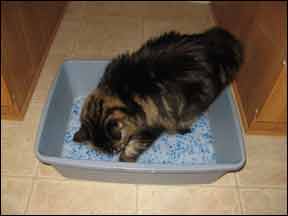Diabetes mellitus in cats is similar to the human disease. The cat cannot efficiently use the sugar (glucose) she takes in with her diet. This is because either she is not producing sufficient amounts of insulin — which regulates the body’s use of sugar — or the cat’s body cannot respond to insulin. One key to treating a diabetic cat is to stabilize her diet and feeding times to control her weight and the amount of glucose in her blood.

288
Diabetes mellitus can be divided into two different types in cats: insulin-dependent diabetes mellitus (IDDM), and non-insulin-dependent diabetes mellitus (NIDDM). Approximately one-half to three-quarters of diabetic cats will require insulin injections as soon as the disease is diagnosed. The rest have NIDDM — however, most ultimately require insulin injections to control their disease. (See related article in September 2011 issue of CatWatch.)
While diabetes mellitus can affect any cat, it is most common in older, obese cats, and males are more commonly afflicted than females. The exact cause of the disease in cats is not known, although obesity (the major predisposing condition), chronic pancreatitis, other hormonal diseases (e.g., hyperthyroidism and Cushing’s disease) and certain medications have all been linked to the disease.
Fat Cats, Thin Cats. In addition to medication, a critical step in treating diabetes is to alter your cat’s diet. Obesity is a major factor in insulin sensitivity, so if your cat is overweight, you will need to help him lose weight gradually. Your veterinarian can help you to tailor a safe weight-loss program, in which your cat loses weight gradually. A high-fiber, high-complex carbohydrate diet not only can achieve weight loss if necessary, but is believed to help control blood sugar levels after eating. (Underweight cats should initially be fed a high calorie diet until they reach their ideal body weight.)
Other diabetic cats respond well to carbohydrate-restricted diets. Although diabetic cats have been successfully managed with both types of diets, some cats respond better to high-fiber diets and others to low-carbohydrate diets. Trial and error can certainly help in determining the best diet for your cat. Maintain communication with your veterinarian as your finetune the process.
Your cat’s feeding routine is also important. While many cats are “free-choice” feeders (i.e., food is left out for them to eat whenever they want), this may not be the ideal routine for the average diabetic cat. Ideally, a cat receiving insulin should be fed half its daily food requirement at the time of each injection, with the unconsumed remainder available throughout the day. The timing of feedings is less critical for cats receiving glipizide; nevertheless, food intake should be closely monitored.
Unfortunately, there is no cure for diabetes mellitus. However, some diabetic cats may eventually lose the need for insulin — months or years after diagnosis. If diabetes has resulted from obesity, it is likely to improve a great deal — or even completely resolve — once the cat’s weight is under control.
If obesity or some other disorder is not a factor, the diabetes probably will not go away, but it can be successfully managed. Luckily, the serious chronic complications that afflict people with diabetes mellitus (such as kidney disease, blood vessel disease and coronary artery disease) are uncommon in diabetic cats. Once control is attained with proper treatment and home care, a diabetic cat can live many healthy years. Nonetheless, successfully managing a diabetic cat does require considerable dedication and communication between you and your veterinarian.


